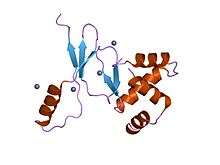Ferric uptake regulator family
| FUR | |||||||||
|---|---|---|---|---|---|---|---|---|---|
 ferric uptake regulator | |||||||||
| Identifiers | |||||||||
| Symbol | FUR | ||||||||
| Pfam | PF01475 | ||||||||
| Pfam clan | CL0123 | ||||||||
| InterPro | IPR002481 | ||||||||
| SCOP | 1mzb | ||||||||
| SUPERFAMILY | 1mzb | ||||||||
| |||||||||
| Ferric uptake regulatory protein | |
|---|---|
| Identifiers | |
| Organism | |
| Symbol | Fur |
| PDB | 2FU4 |
| UniProt | P0A9A9 |
In molecular biology, the ferric uptake regulator family is a family of bacterial proteins involved in regulating metal ion uptake and in metal homeostasis. The family is named for its founding member, known as the ferric uptake regulator or ferric uptake regulatory protein (Fur). Fur proteins are responsible for controlling the intracellular concentration of iron in many bacteria. Iron is essential for most organisms, but its concentration must be carefully managed over a wide range of environmental conditions; high concentrations can be toxic due to the formation of reactive oxygen species.[1]
Function
Members of the ferric uptake regulator family are transcription factors that primarily exert their regulatory effects as repressors: when bound to their cognate metal ion, they are capable of binding DNA and preventing expression of the genes they regulate, but under low concentrations of metal, they undergo a conformational change that prevents DNA binding and lifts the repression.[2][3] In the case of the ferric uptake regulator protein itself, its immediate downstream target is a noncoding RNA called RyhB.[2]
In addition to the ferric uptake regulator protein, members of the Fur family are also involved in maintaining homeostasis with respect to other ions:[4]
- Mur, responsive to manganese.[5]
- Nur, responsive to nickel.[6]
- PerR, responsive to peroxide; PerR monomers contain two binding sites and occur in zinc/iron and zinc/manganese forms.[5]
- Zur, responsive to zinc; Zur regulates uptake and transport through a regulon involving ZinT and the transporter ZnuABC.[7][8]
The iron dependent repressor family is a functionally similar but non-homologous family of proteins involved in iron homeostasis in prokaryotes.[1]
Relationship to virulence
Metal homeostasis can be a factor in bacterial virulence, an observation with a particularly long history in the case of iron.[9][10][11] In some cases, expression of virulence factors is under the regulatory control of the Fur protein.[1][2]
References
- 1 2 3 Pohl E, Haller JC, Mijovilovich A, Meyer-Klaucke W, Garman E, Vasil ML (Feb 2003). "Architecture of a protein central to iron homeostasis: crystal structure and spectroscopic analysis of the ferric uptake regulator". Molecular Microbiology. 47 (4): 903–15. doi:10.1046/j.1365-2958.2003.03337.x. PMID 12581348.
- 1 2 3 Porcheron G, Dozois CM (Aug 2015). "Interplay between iron homeostasis and virulence: Fur and RyhB as major regulators of bacterial pathogenicity". Veterinary Microbiology. 179 (1-2): 2–14. doi:10.1016/j.vetmic.2015.03.024. PMID 25888312.
- ↑ Gilston BA, Wang S, Marcus MD, Canalizo-Hernández MA, Swindell EP, Xue Y, Mondragón A, O'Halloran TV (Nov 2014). "Structural and mechanistic basis of zinc regulation across the E. coli Zur regulon". PLoS Biology. 12 (11): e1001987. doi:10.1371/journal.pbio.1001987. PMC 4219657
 . PMID 25369000.
. PMID 25369000. - ↑ Waldron KJ, Robinson NJ (Jan 2009). "How do bacterial cells ensure that metalloproteins get the correct metal?". Nature Reviews. Microbiology. 7 (1): 25–35. doi:10.1038/nrmicro2057. PMID 19079350.
- 1 2 Troxell B, Hassan HM (2013). "Transcriptional regulation by Ferric Uptake Regulator (Fur) in pathogenic bacteria". Frontiers in Cellular and Infection Microbiology. 3: 59. doi:10.3389/fcimb.2013.00059. PMC 3788343
 . PMID 24106689.
. PMID 24106689. - ↑ Ahn BE, Cha J, Lee EJ, Han AR, Thompson CJ, Roe JH (Mar 2006). "Nur, a nickel-responsive regulator of the Fur family, regulates superoxide dismutases and nickel transport in Streptomyces coelicolor". Molecular Microbiology. 59 (6): 1848–58. doi:10.1111/j.1365-2958.2006.05065.x. PMID 16553888.
- ↑ Graham AI, Hunt S, Stokes SL, Bramall N, Bunch J, Cox AG, McLeod CW, Poole RK (Jul 2009). "Severe zinc depletion of Escherichia coli: roles for high affinity zinc binding by ZinT, zinc transport and zinc-independent proteins". The Journal of Biological Chemistry. 284 (27): 18377–89. doi:10.1074/jbc.M109.001503. PMC 2709383
 . PMID 19377097.
. PMID 19377097. - ↑ Blindauer CA (Mar 2015). "Advances in the molecular understanding of biological zinc transport". Chemical Communications. 51 (22): 4544–63. doi:10.1039/c4cc10174j. PMID 25627157.
- ↑ Bullen JJ, Rogers HJ, Griffiths E (1978). "Role of iron in bacterial infection". Current Topics in Microbiology and Immunology. 80: 1–35. PMID 352628.
- ↑ Ratledge C, Dover LG (2000). "Iron metabolism in pathogenic bacteria". Annual Review of Microbiology. 54: 881–941. doi:10.1146/annurev.micro.54.1.881. PMID 11018148.
- ↑ Litwin CM, Calderwood SB (Apr 1993). "Role of iron in regulation of virulence genes". Clinical Microbiology Reviews. 6 (2): 137–49. doi:10.1128/cmr.6.2.137. PMC 358274
 . PMID 8472246.
. PMID 8472246.
This article incorporates text from the public domain Pfam and InterPro IPR002481